I put the Google Pixel 8 Pro vs Galaxy S23 Ultra through a 7-round face-off — here’s the winner
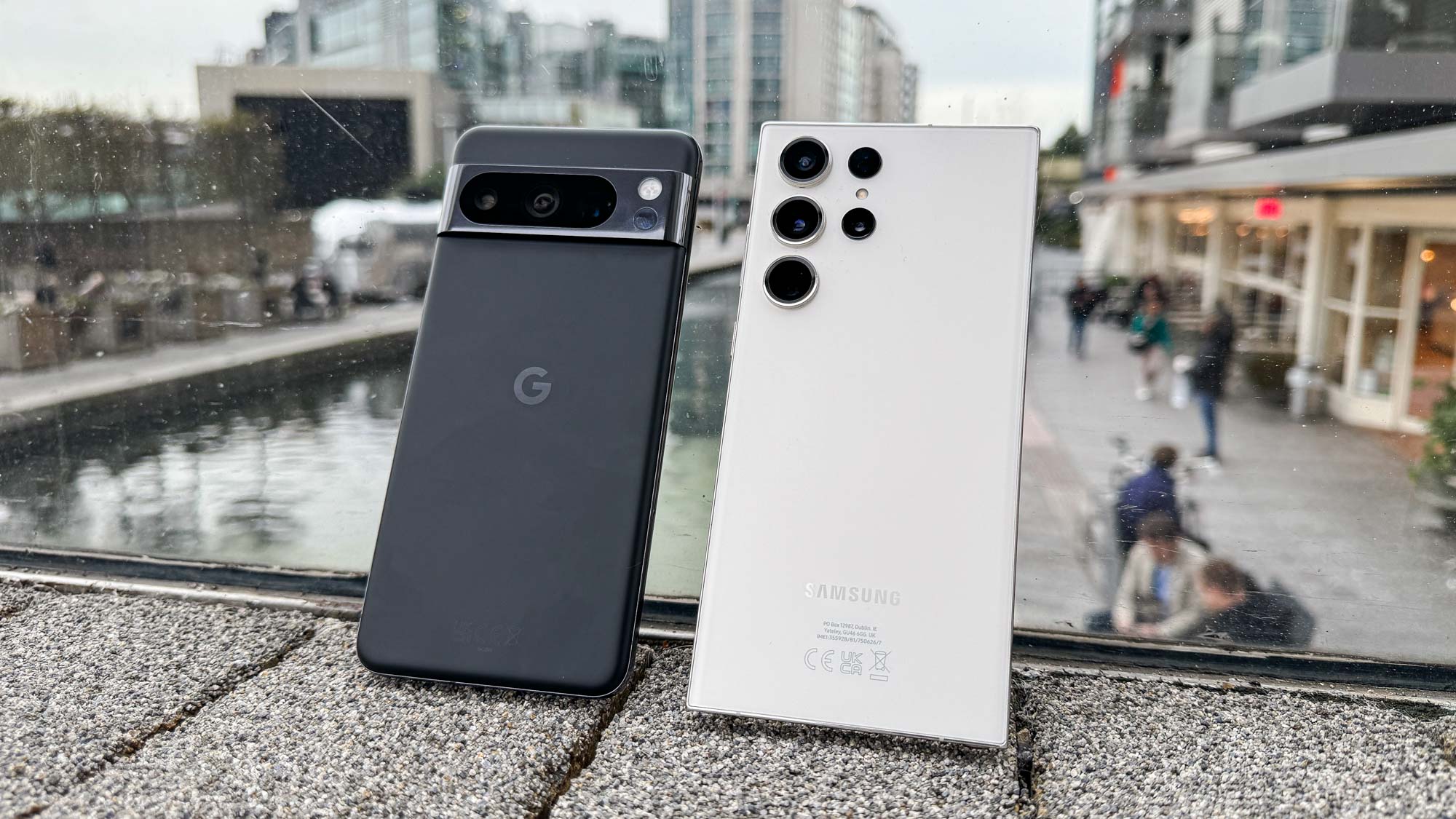
The Google Pixel 8 Pro and Samsung Galaxy S23 Ultra are two of the top Android phones you can buy. But figuring out which is the right one for your needs is tricky, so we're here to help guide your decision.
Google's Pixel 8 Pro is the newer of the two phones, and costs less while also impressing with all sorts of unique AI and software features. The Galaxy S23 Ultra offers a more versatile camera system though, plus a superior processor and battery. Both phones are excellent, the only question is which will suit you better.
In this Pixel 8 Pro vs Galaxy S23 face-off, I compare the specs, design, display, performance, cameras and more to determine the overall winner.
Google Pixel 8 Pro vs. Samsung Galaxy S23 Ultra: Specs
| Pixel 8 Pro | Galaxy S23 Ultra | |
| Price | $999 / £999 / A$1,699 | $1,199 / £1,249 / A$1,949 |
| Display | 6.7-inch Super Actua Display (OLED) | 6.8-inch QHD AMOLED |
| Display resolution | 2,992 x 1,344 | 3,088 x 1,440 |
| Refresh rate | 1 - 120Hz adaptive | 1 - 120Hz adaptive |
| Rear cameras | 50MP main, 48MP ultrawide, 48MP 5x telephoto | 200MP main, 12MP ultrawide, 10MP 3x telephoto, 10MP 10x telephoto |
| Front camera | 10.5MP selfie | 12MP selfie |
| Chipset | Google Tensor G3 | Snapdragon 8 Gen 2 for Galaxy |
| RAM | 12GB | 8GB/12GB |
| Storage | 128GB/256GB/512GB/1TB | 256GB, 512GB, 1TB |
| Battery | 5,050 mAh | 5,000 mAh |
| Charging | 30W wired / 23W wireless (with Pixel Stand) | 45W wired / 10W wireless |
| Water/dust resistance | IP68 | IP68 |
| Size | 6.4 x 3.0 x 0.3 inches (162.6 x 76.5 x 8.8mm) | 6.4 x 3.0 x 0.35 inches (163.4 x 78.1 x 8.9mm) |
| Weight | 7.5 ounces (213g) | 8.2 ounces (233g) |
| Colors | Obsidian, Porcelain, Bay | Phantom Black, Cotton Flower, Botanic Green and Mystic Lilac |
Google Pixel 8 Pro vs. Samsung Galaxy S23 Ultra: Price and availability
The Google Pixel 8 Pro launched in October 2023, so it's the newer of the two phones in this comparison. It starts at a price of $999 / £999 / A$1,699, which has increased from last year, but that's still a reasonable price for an Android flagship phone.
Meanwhile, the Galaxy S23 Ultra's been on sale for longer, first launching in February 2023. It goes for $1,199 / £1,249 / A$1,949 in its basic spec, which is still more expensive than the Pixel 8 Pro, even with Google's price hike.
Winner: Google Pixel 8 Pro
Google Pixel 8 Pro vs. Samsung Galaxy S23 Ultra: Design
You can't accuse Google and Samsung of copying each other's designs. While the two phones are similar from the front, both are distinct from the back, with the Samsung separating all its cameras out into individual metal-ringed lenses, and Google combining all of them into a horizontal camera bar. The Pixel 8 Pro also features rounded corners, while the Galaxy has sharp right-angled ones.
Get instant access to breaking news, the hottest reviews, great deals and helpful tips.
The Galaxy S23 Ultra is a little thicker and heavier than the Pixel 8 Pro, which may be a key consideration for users wanting an easy-to-handle phone. But these are still both 6.7-inch handsets, and as a result are still both quite large.
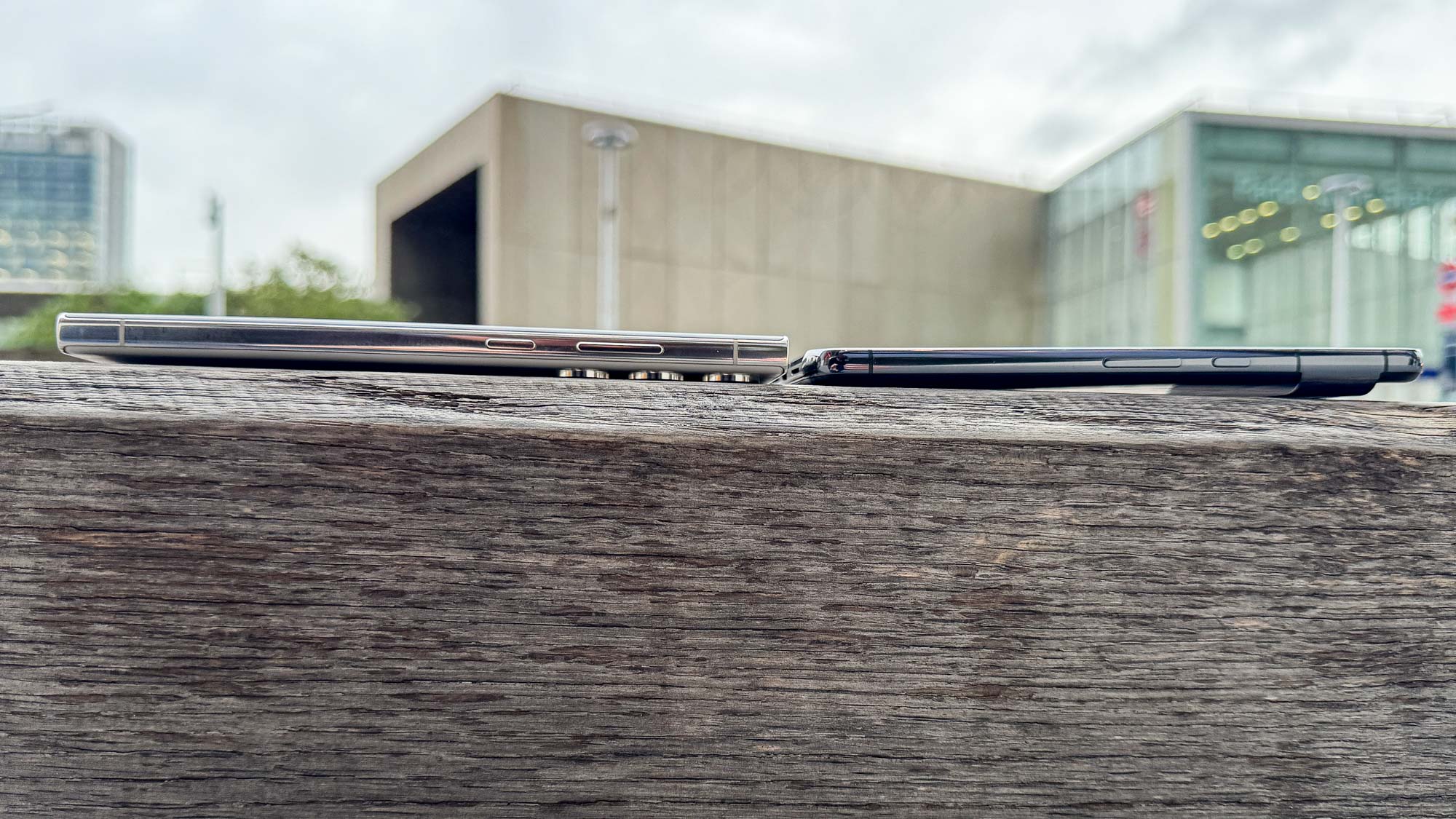
One other important difference is that there's a flat display on Pixel, which is likely better for the majority of users. The Galaxy S23 has a subtly curved screen which looks and feels great, but is not something everyone likes because of curved displays' increased risk of mis-taps.
Winner: Google Pixel 8 Pro
Google Pixel 8 Pro vs. Samsung Galaxy S23 Ultra: Display
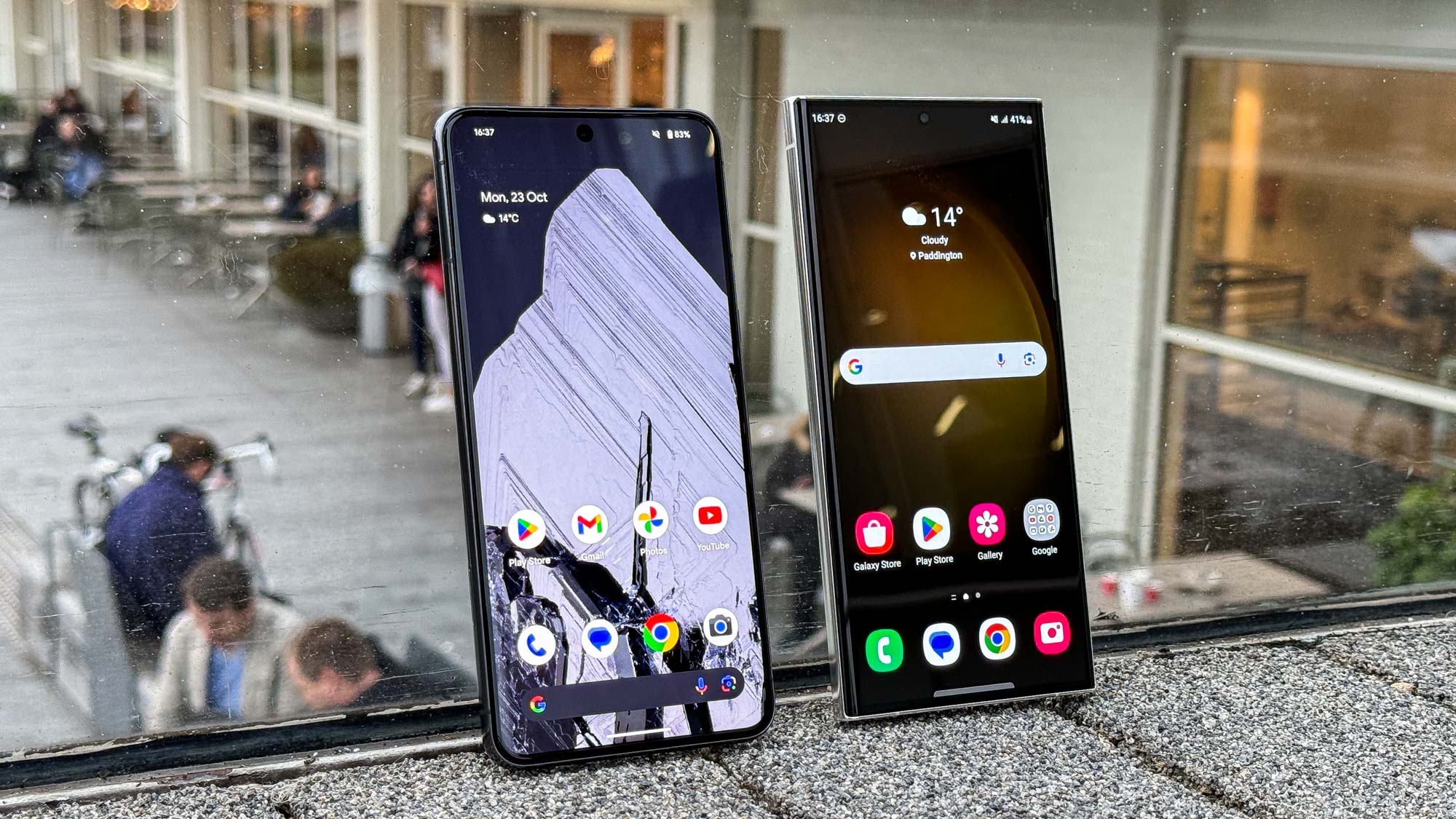
The Google Pixel 8 Pro's 6.7-inch screen is branded Super Actua, and the Galaxy S23 Ultra's slightly larger 6.8-inch panel is AMOLED, but both are at their heart OLED displays with 1 - 120Hz adaptive refresh rates.
Based on our testing, the Pixel 8 Pro's panel is very good, but it trails the Galaxy S23 Ultra in a few areas. The Galaxy S23 Ultra's screen delivers a higher brightness level of 1,526 when showing HDR content, compared to 1,444 nits for Google's phone. But both numbers are very good.
| Row 0 - Cell 0 | Pixel 8 Pro (default Adaptive display color setting) | Galaxy S23 Ultra (default Vivid display color setting) |
| Max brightness (nits) | 1,444 | 1,526 |
| DCI-P3 color gamut coverage (percent) | 78.4% (Natural) / (Adaptive) 90.4% | 78.8% (Natural) / 136.7% (Vivid) |
| Delta-E color accuracy score (lower is better) | 0.37 | 0.25 |
In terms of color gamut coverage, the Galaxy S23 Ultra wins again regardless of screen mode, although it's close in Natural mode. Lastly, the Galaxy S23 Ultra also delivered a better Delta-E color accuracy score of 0.25 vs 0.37 for the Pixel 8 Pro. In this test 0 is perfect so a lower score is better.
Winner: Samsung Galaxy S23 Ultra
Google Pixel 8 Pro vs. Samsung Galaxy S23 Ultra: Cameras
For your photography needs, Google equipped the Pixel with a 50MP main camera, 48MP ultrawide camera and 48MP 5x telephoto camera combo on the back, and a 10.5MP selfie camera on the front.
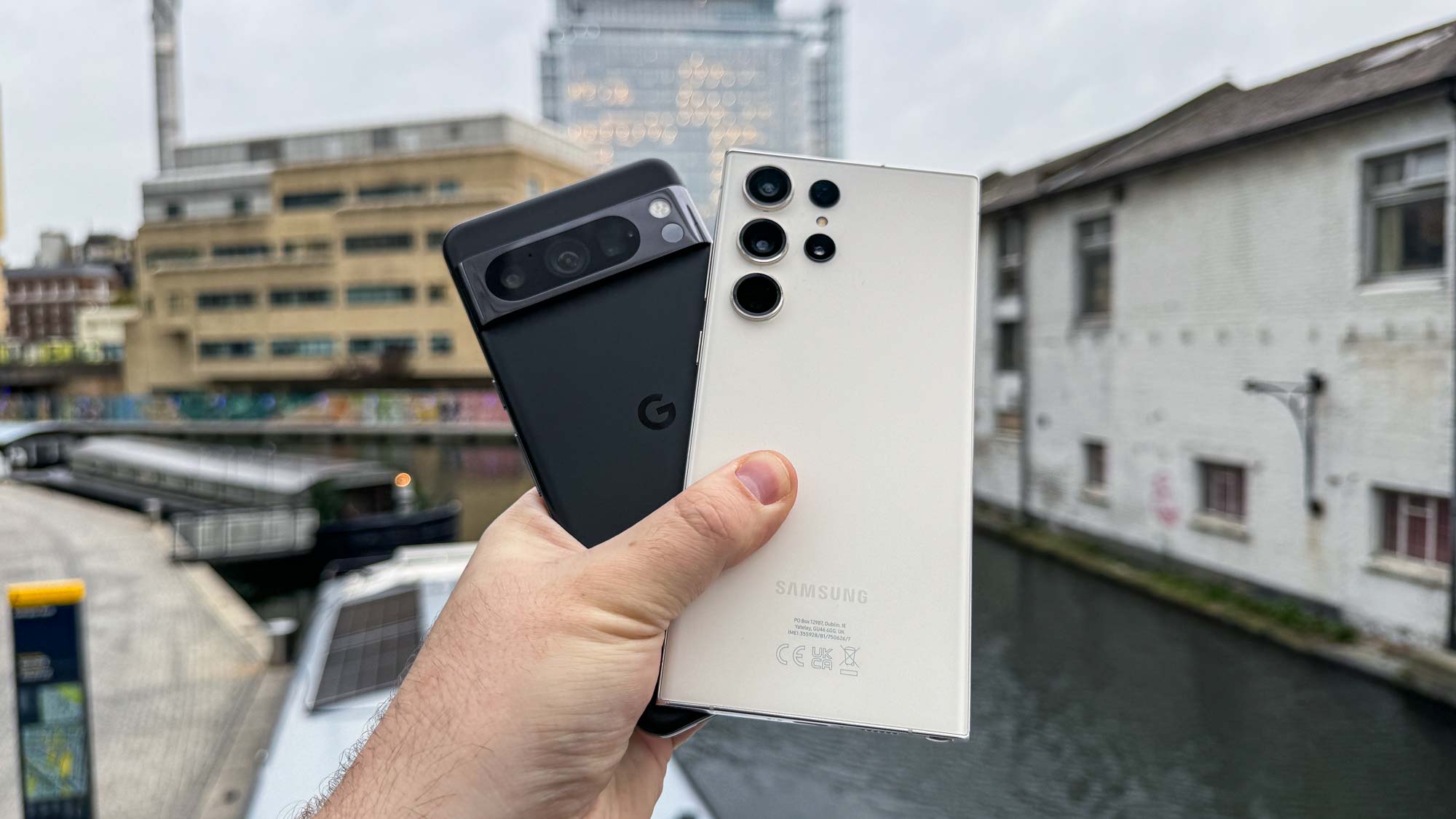
The Galaxy S23 Ultra on paper does better, with a 200MP main camera, 12MP ultrawide camera, and two 10MP telephoto cameras that allow the S23 Ultra to cover both 3x and 10x magnification with dedicated optical lenses. There's a 12MP front camera, too.
Starting with the main camera, we have an image of a giant plug (a piece of public art in Paddington Basin). The metal looks a little warmer through the Pixel 8 Pro's lens, while the colors are more saturated in the Samsung photo. Stronger colors can be a detriment to the Galaxy S23 Ultra's photos sometimes, but it works nicely here.
In night/low-light mode, this chopping board and set of cheese knives look brighter and more natural from the Pixel 8 Pro, although the warm colors in the Galaxy S23 Ultra's photo is still appealing.
Moving to the ultrawide camera, Sussex Gardens looks more natural in the Pixel 8 Pro shot, and more vivid in the Samsung's. The HDR of the Pixel seems to be far better though, giving us a far clearer view of the garden's central plant bed than the Samsung manages.
Now we have a trio of telephoto comparisons, so we can see how the two phones manage at different zoom levels. At 3x, the Galaxy is the winner, offering a far brighter and sharper photo of the old GWR building over on the other side of Paddington Station.
At 5x, the Pixel's native magnification, we see a reversal, with the Galaxy's image starting to look fuzzy and drab instead.
Finally at 10x, the Galaxy S23 Ultra gets to use its second telephoto camera, giving us another clean shot. The Pixel 8 Pro gets to flex the hybrid zoom abilities of its telephoto camera, offering a surprisingly good image despite needing to crop in digitally.
Lastly, we come to a selfie portrait comparison. The Pixel's controlled the light better, and provided richer colors, but the portrait effect hasn't cut my glasses out properly. The Samsung managed to understand my glasses frame needs to be part of the foreground, and still looks fairly good even with its uneven lighting.
For me, the Pixel 8 Pro takes photos the way I want them to be more of the time. But having the versatility of the extra telephoto camera on the Galaxy S23 Ultra has proved handy several times, and its tendency to saturate images can produce striking photos under the right circumstances. So overall, this part of the contest is too close for me to declare a winner.
Winner: Draw
Google Pixel 8 Pro vs. Samsung Galaxy S23 Ultra: Performance
The Pixel 8 Pro's Tensor G3 chipset is focused on AI rather than power, meaning that it understandably underperforms in the benchmarks we used to test the phones.
| Row 0 - Cell 0 | Pixel 8 Pro | Galaxy S23 Ultra |
| Geekbench 5 (single-core / multi-core score) | 1,163 / 2,745 | 1,578 / 5,081 |
| 3DMark Wild Life Extreme Unlimited (score / fps) | 2,250 / 13 fps | 3,788 / 22 fps |
| Adobe Premiere transcoding test (mins:secs) | 0:46 | 0:39 |
The customized Snapdragon 8 Gen 2 for Galaxy chip found within the Galaxy S23 Ultra wins on all three of the tests we run, which cover CPU and GPU power. The S23 Ultra has a major advantage in multi-core performance on Geekbench, and It's actually one of the most powerful phones on the market today.
Looking beyond power, the Galaxy S23 Ultra also gets points for having a higher default storage of 256GB, compared to the Pixel 8 Pro's 128GB. But the Pixel 8 Pro does offer 12GB of RAM by default, rather than 8GB as the basic S23 Ultra does.
Winner: Samsung Galaxy S23 Ultra
Google Pixel 8 Pro vs. Samsung Galaxy S23 Ultra: Battery and charging
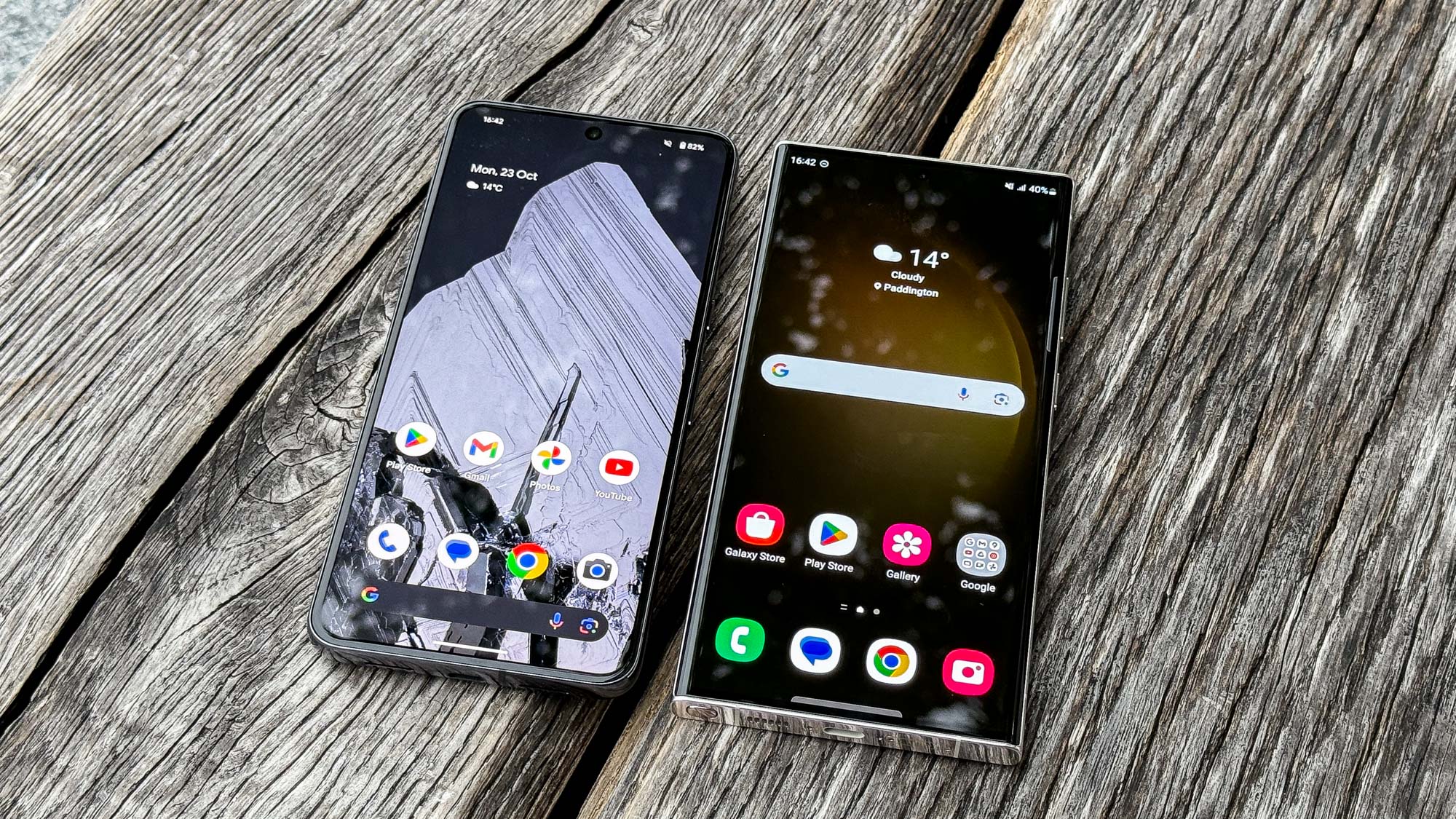
Battery life on the Pixel 8 Pro is much improved from previous Pixels, but it can't quite match the Galaxy S23 Ultra. When we tested the phones on their default 120Hz refresh rate settings, the Pixel 8 Pro averaged 8 hours and 33 minutes and the Samsung endured for a much longer 12:22.
When we switched over to 60Hz display mode, the Pixel 8 Pro averaged 9:46 vs 13:09 for the Galaxy S23 Ultra. So Samsung wins on battery life for sure.
On paper, the Galaxy S23 Ultra beats the Pixel 8 Pro when it comes to charging speeds. There's a maximum of 45W wired charging on the S23 Ultra, while the Pixel is limited to 30W. However, in our testing the Pixel 8 Pro charged slightly faster at 59% in 30 minutes compared to 57% in the same amount of time for Samsung.
You do get slightly faster wireless charging on the Pixel 8 Pro though, with 23W available to Pixel Stand users. The Samsung offers a standard Qi wireless charging speed of 15W.
Winner: Samsung Galaxy S23 Ultra
Google Pixel 8 Pro vs. Samsung Galaxy S23 Ultra: Software and special features
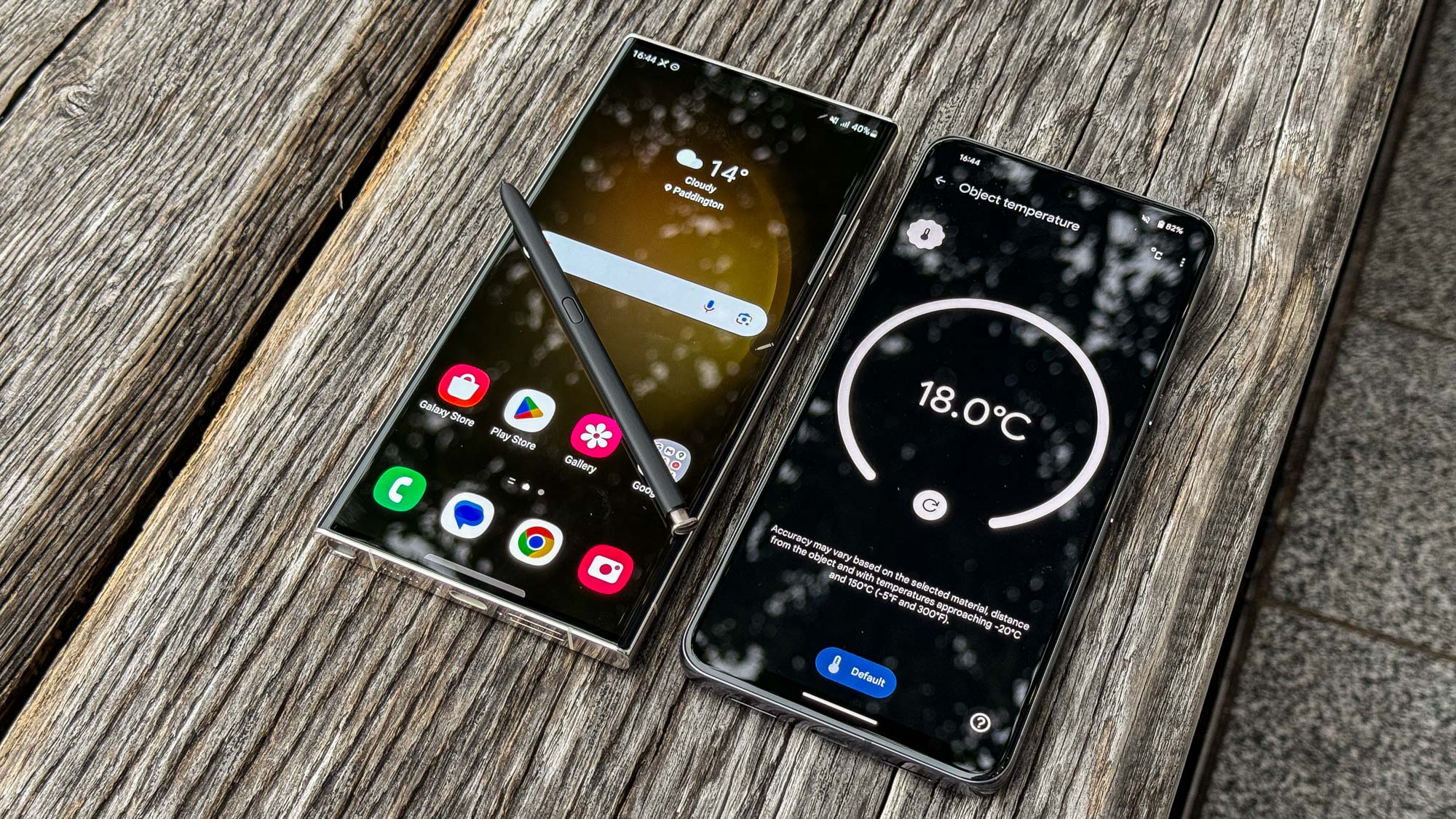
At the time of writing, the Galaxy S23 Ultra runs on Android 13, while the Pixel 8 Pro comes pre-installed with Android 14. Samsung should be updating the S23 Ultra to Android 14 soon, but for now it's a software generation behind the Pixel.
Google has poured a lot of AI magic in the Pixel 8 Pro, meaning that you get a lot of fun things to play with beyond just the additional features of Android 14. That includes photo and video editing, like Best Take, Magic Editor and Magic Eraser for photos and video audio, as well as more productivity-focused ones like call screening and the Summarize function for condensing long text passages into an automated TL:DR.
There's also a temperature sensor on the back of the Pixel 8 Pro that can be used to gauge how hot or hold various objects are. It's gimmicky, but it's something you'd be hard-pressed to find on another new phone.
Samsung's One UI version of Android comes with its own unique features, like stacks for home screen widgets, text-to-voice for answering phone calls quietly and some similar AI photo editing abilities to Google. But in terms of the Galaxy S23 Ultra itself, its biggest advantage is the included S Pen stylus.
Stylus support for phones is rare enough, but the Bluetooth-powered S Pen is on another level. It's extremely responsive when drawing or making notes, and can also be used as a remote control or alternative control method for several apps.
It's also worth considering how many years of software support are promised for these phones. The Galaxy S23 Ultra will get four years of updates, including the incoming Android 14 update. Google is offering seven years of updates on the Pixel 8 Pro, which is currently unmatched among Android phones. So buying a new Pixel could mean you're sorted for a phone until the end of the decade if you really want to stretch out the gap between phone purchases.
Winner: Google Pixel 8 Pro
Google Pixel 8 Pro vs. Samsung Galaxy S23 Ultra: Verdict
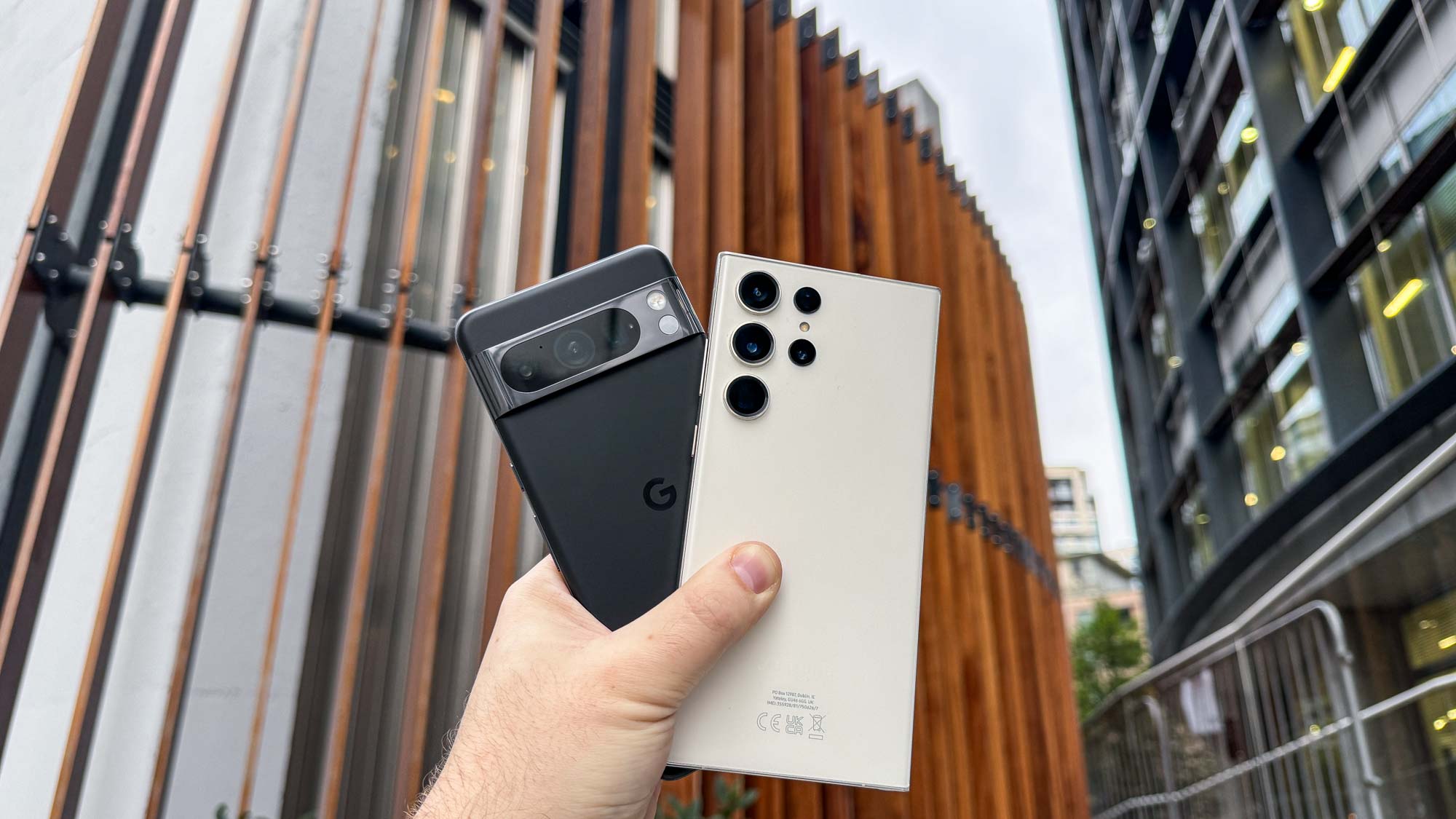
Adding up the overall rounds, we see that the Google Pixel 8 Pro and Samsung Galaxy S23 Ultra are very close in overall quality. But there's a clear winner when you total up the points.
| Row 0 - Cell 0 | Pixel 8 Pro | Galaxy S23 Ultra |
| Price (15 points) | 14 | 11 |
| Design (10 points) | 9 | 8 |
| Display (10 points) | 8 | 9 |
| Cameras (25 points) | 23 | 23 |
| Performance (15 points) | 9 | 13 |
| Battery and charging (15 points) | 10 | 14 |
| Software and special features (10 points) | 9 | 7 |
| Total | 82 | 85 |
The Galaxy S23 Ultra is the victor in this face-off, earning this via its stronger display, performance and battery life. However, its higher price may be all you need to push you towards the Pixel 8 Pro instead.
There are still strong reasons to go for the Pixel instead of the Galaxy beyond just the pricing. Its cameras are just as good, and perhaps are even better if you want an easy way to edit your photos. And you get much longer software support. So you can't lose with either flagship.
More from Tom's Guide
- See where these phones lie on our best Android phones guide
- OnePlus Open vs Pixel Fold vs Galaxy Z Fold 5 low-light photos — here's the winner
- Motorola’s adaptive display could let you wear your phone like a smartwatch

Richard is based in London, covering news, reviews and how-tos for phones, tablets, gaming, and whatever else people need advice on. Following on from his MA in Magazine Journalism at the University of Sheffield, he's also written for WIRED U.K., The Register and Creative Bloq. When not at work, he's likely thinking about how to brew the perfect cup of specialty coffee.
